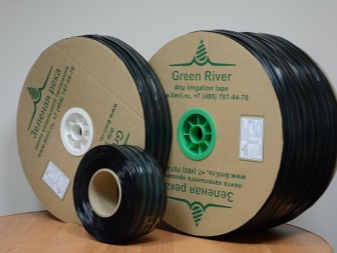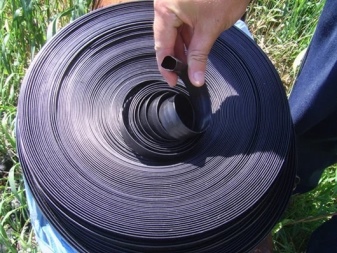Drip Irrigation Tapes

Tape for drip irrigation has been used for quite some time, but not everyone knows the features of the emitter tape and other types, their differences. In the meantime, it's time to figure out which variety is better, and how to clean the tape. Having learned how such a product works and how to choose it, you can proceed to installation.


What it is?
A bucket or watering can has long ceased to be the only attributes of watering a summer cottage, garden and vegetable garden. They were replaced by hoses. But even they leave a lot of manual work. However, there is an even less laborious solution. Drip irrigation tape is one of the most important tools in the work of a modern gardener.
It works in general with practically no expenditure of physical strength. More precisely, the initial installation will require some effort, but then their application will pay off many times over. Already many hundreds and thousands of people have appreciated the benefits of this scheme. The essence is extremely simple and understandable even for elementary schoolchildren: a tape with holes in pre-selected places is connected to the water supply. All that is needed during use is, as in the old advertising phrase, "just add water", or, more precisely, just turn off the valve.

Belt irrigation is almost universal. It applies:
- in ordinary gardens;
- in gardens;
- at dachas;
- on adjoining lawns and lawns;
- for flowers and fruit trees, for vegetables and berry bushes, and for all other crops too.
The efficiency of the design is beyond doubt. The service life of the tape under normal conditions is quite long. It is this solution that takes first place among all methods of even the most drip irrigation in terms of practicality.
But before figuring out which products of which company should be preferred, you need to understand the types that are present on the modern market. It is their qualities that are the decisive guideline in the selection.


What are they?
Slotted
This type of belt sprinkler has a labyrinth feed channel inside. It is built into the whole structure. When driving along the highway, the water slows down, and its consumption is normalized. The models may differ in the shape of the water passage, and sometimes even they are patented. But for the consumer, such nuances are of very little importance; stacking and unwinding can be mechanized without much difficulty.


Labyrinth
Differences from the previous version are due to the fact that the channel is laid directly over the surface of the tape. There is no point, accordingly, to invade its structure, to be sophisticated with lasers and so on. However, these advantages relate only to the activities of manufacturers. End consumers have long recognized that a simple labyrinth tape is a purely consumable material, and its only conditional plus is its low price. At the same time, the affordable cost inevitably turns around:
- a high probability of deformation of the labyrinth, even just when unwinding or winding back;
- great difficulty in stacking with the release upward;
- fast clogging (since the water channel is in direct contact with the ground and with everything on it);
- uneven irrigation (and more importantly, no engineering tricks can solve at least one of the indicated problems).


Emitter
Structures of this type are made with emitters, that is, with separate droplet channels of a flattened configuration. They are inserted inside the tape, observing the distance specified in the project. This performance is appreciated in that the likelihood of blockages is minimized. During operation, turbulent flows are formed inside the dropper, literally shaking dirt particles, and therefore guaranteeing the speed of its removal.
A side effect is that the emitter tape has almost no requirements for water filtration. You don't even have to think about installing any special filters. Contrary to expectations, there are no special extra charges for such a product.
The closer the droppers are placed inside, the more expensive the tape. This is quite predictable, since such a decision greatly complicates the work, increases the requirements for the qualifications of both performers and inspectors of the quality control department.


Manufacturers
Tapes have a good reputation "Green River" from the "Center of Innovations" company.
This manufacturer emphasizes in the description:
- to thoroughly check the quality of raw materials in laboratories;
- direct cooperation with leading research institutions in the field of land reclamation technologies;
- the presence of internal production of emitters;
- availability of patented technologies.
You should also pay attention to the Neo-Drip from the "New Age of Agrotechnology" company. The size of the reels sold varies from 50 to 3000 m. The uniformity of water dissipation at any distance is declared. The manufacturer also focuses on the material's resistance to chemicals used in agriculture. Finally, it is useful to note the presence of solutions designed for both a large agricultural firm and a dacha farm or a personal plot.


Stand out from other suppliers:
- PESTAN;
- Viola LLC;
- "Polyplastic";
- "Master Drip".


Which one is better to choose?
When selecting irrigation tapes, emitter structures should be unambiguously given preference. Slotted varieties are acceptable (but no more) when installed on a solid surface (asphalt, concrete) for irrigation of small flower beds and flower beds. Regardless of the type of tape, attention must be paid to its section. Usually, the 16 mm version is enough, and the 22 mm is advisable mainly on large plantations. Then pay attention to the thickness of the walls.
With a layer of 0.125 mm, you can confidently water annuals with a short growing season. Other plants can be irrigated only on land containing few stones. This solution is also suitable for indoor use. Other options are:
- 0.015 cm - for long-maturing crops;
- 0.02 cm - also for crops with long ripening, can be reused provided careful work;
- 0.025 and 0.03 cm - a similar tape is needed on stony ground;
- 0.375 cm - design for areas with pronounced rockiness, as well as for places where mechanical damage is active.


But the thickness only affects the reliability of the structure. Other properties do not depend on it. In everyday life, it is best to use a relatively thin tape. The emitter pitch is important in the sense that it should correspond to the proximity of planting and the intensity of moisture absorption. So, on sandy ground, it should be minimal (10-20 cm), and on medium-grain soil, 30 cm is enough.
Additionally take into account:
- water consumption;
- permissible internal pressure;
- reputation of the manufacturers.


How to install correctly?
Plastic fittings are used to mount the irrigation tape. They have proven to be excellent when joining with a polyethylene pipe. This bundle has been working steadily for many years. The strip must be laid either near each row, or between two close beds. Usually, the simplest and lowest tape consumption option is chosen. The drip holes should be oriented upward. The supply line is placed at an angle of 90 degrees to the tape. The edges of the strip will have to be drowned out.
Gravity feed is possible when the tank is installed at a height of 2 m or higher. But it must be borne in mind that such an approach will not ensure the uniformity of the pressure and the uniform quality of irrigation. Before installing the drip tape, it is useful to study the site plan and measure all slopes and rises. Then you can draw up an optimal device diagram.They think in advance about the installation points of the shut-off valves.
To reduce the likelihood of tape and pipe clogging, it is still worth using filters. The entire system is flushed up to start-up.


How to use?
It is possible to plant any crops only after the installation of an irrigation line. In the summer, special work is not carried out on it. Only sometimes you have to clean the filters, replace the deformed tubes, tapes. When the season is over, the water is immediately poured out. All components are left to dry for 4-5 days. Then the drip circuit is disconnected, disassembled and stored. It should be noted that negative temperatures are not dangerous for dry plastic. Bends and twisting into the bay harm him much more seriously.
It is best to leave the tapes unfolded. To prevent them from being dragged by the wind, it is useful to tie to a fence.


Additional recommendations:
- combine simple watering with the addition of fertilizers;
- water the plants, starting at 2 hours after dawn, finish it 2 hours before sunset;
- use water heated from 20 to 23 degrees (it is more comfortable for plants and avoids many pathologies);
- reduce the intensity of irrigation in cloudy (especially wet) weather and activate it in the heat;
- make sure that there is always water in the supply container for at least one watering;
- disinfect and flush the system every 50-70 days (this is not difficult and saves a lot of time that would otherwise have to be spent on thorough washing in a neglected case).
You can eliminate salts formed in the hose and dropper with nitric or phosphoric acid. Their concentration is normally 0.5 and 1%, respectively. Such solutions are kept inside the hose for about 3 hours. Organic blockages are removed with a solution of 0.02 kg of sodium hydrochloride in 10 liters of water. Again, you will have to wait 2-3 hours.















The comment was sent successfully.